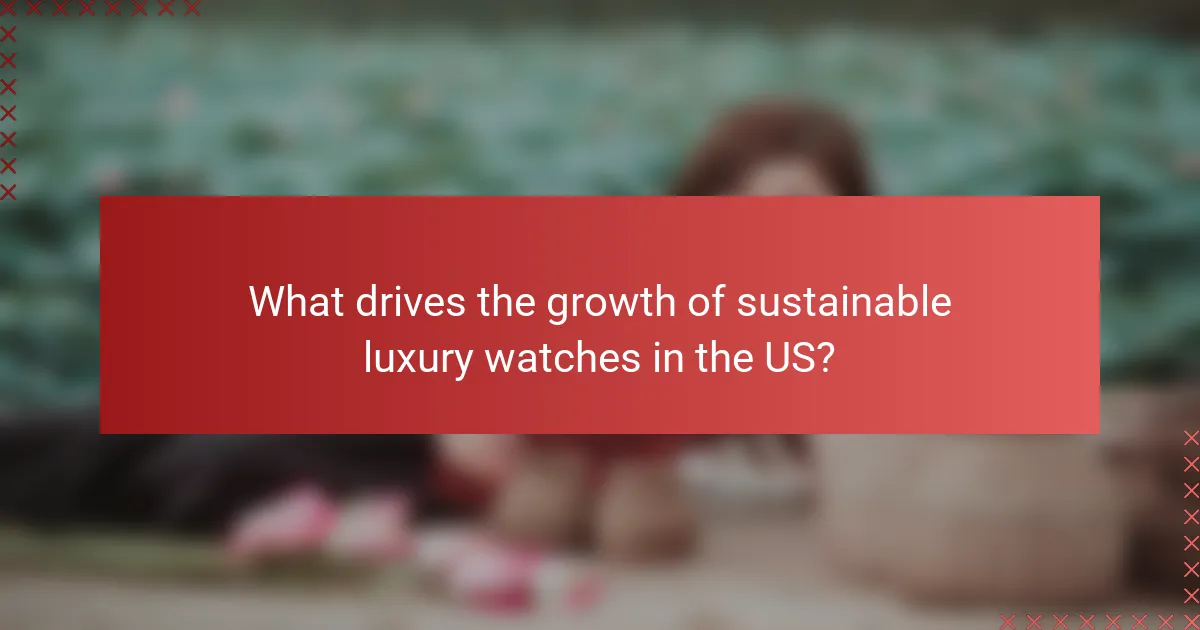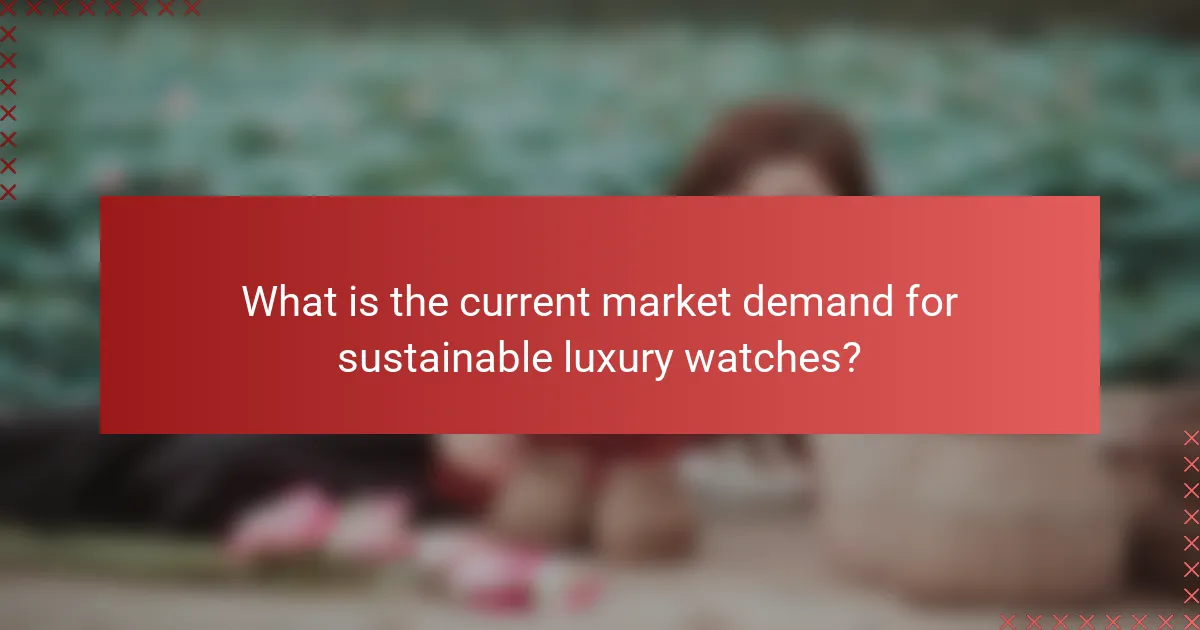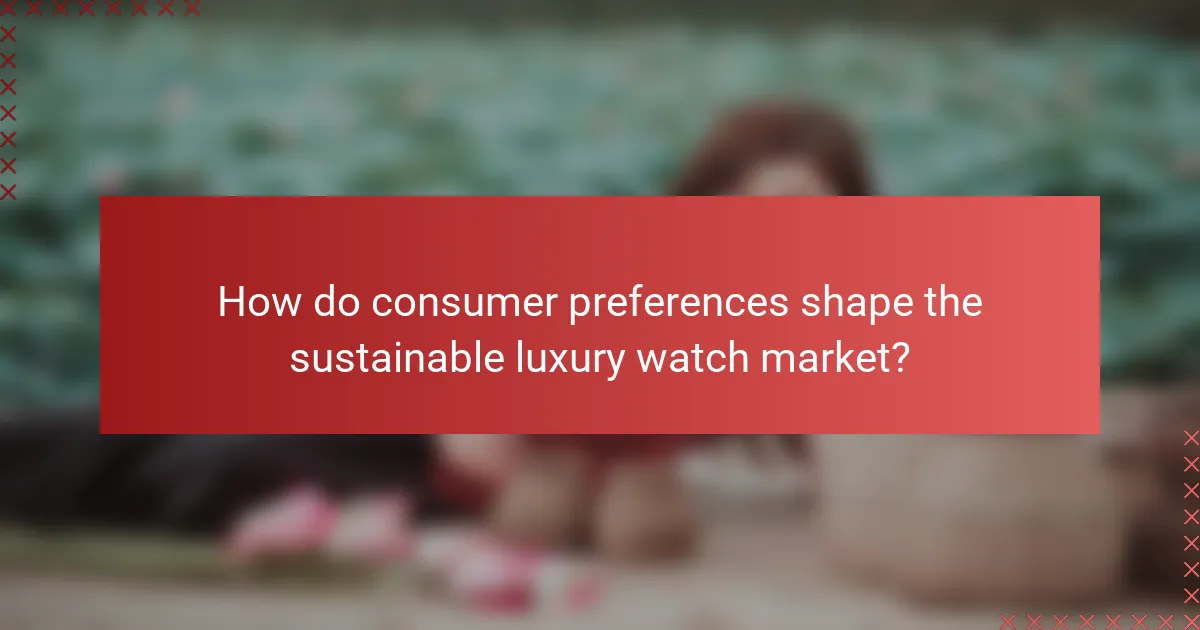The sustainable luxury watch market is experiencing significant growth, fueled by heightened consumer awareness and a preference for eco-friendly materials. As buyers increasingly prioritize sustainability in their purchasing decisions, brands are adapting by embracing transparency and ethical production practices. This shift not only reflects changing consumer values but also drives demand for unique, environmentally conscious timepieces.

What drives the growth of sustainable luxury watches in the US?
The growth of sustainable luxury watches in the US is primarily driven by increasing consumer awareness, a shift towards eco-friendly materials, and brand transparency initiatives. These factors reflect a broader trend where consumers are prioritizing sustainability in their purchasing decisions, influencing how luxury brands operate.
Increased consumer awareness
Consumer awareness regarding environmental issues has significantly risen, leading to a demand for sustainable luxury products. Many buyers are now actively seeking watches that not only showcase craftsmanship but also align with their values on sustainability.
Brands that communicate their commitment to sustainability effectively can attract a more conscientious customer base. This awareness often translates into a willingness to pay a premium for products that are ethically sourced and produced.
Shift towards eco-friendly materials
The luxury watch industry is increasingly adopting eco-friendly materials such as recycled metals, organic leather alternatives, and sustainably sourced wood. This shift not only reduces environmental impact but also appeals to consumers who are concerned about the ecological footprint of their purchases.
For instance, some brands are using biodegradable materials or innovative composites that minimize waste. This trend is expected to continue as technology advances and more sustainable options become available.
Brand transparency initiatives
Transparency in sourcing and manufacturing processes is becoming a critical factor for consumers when choosing luxury watches. Brands that openly share their sustainability practices, supply chain information, and ethical standards are gaining consumer trust.
Many luxury watchmakers are now providing detailed information about their materials and production methods, often highlighting certifications from recognized sustainability standards. This level of transparency not only enhances brand loyalty but also encourages other companies to adopt similar practices.

What is the current market demand for sustainable luxury watches?
The market demand for sustainable luxury watches is on the rise as consumers increasingly seek products that align with their values. This trend reflects a growing awareness of environmental and ethical issues, driving brands to adopt sustainable practices in their manufacturing processes.
Rising sales in North America
Sales of sustainable luxury watches in North America have seen significant growth, reflecting a shift in consumer priorities. Many brands report double-digit percentage increases in sales, driven by younger consumers who prioritize sustainability.
Key factors contributing to this rise include increased marketing efforts focused on sustainability and the availability of eco-friendly options. Brands that highlight their commitment to ethical sourcing and environmentally friendly materials are particularly well-received.
Growth in online luxury watch retail
The online retail sector for luxury watches is expanding rapidly, with many consumers opting for the convenience of shopping from home. E-commerce platforms are now offering a wider selection of sustainable luxury watches, making them more accessible to a broader audience.
Online sales channels allow brands to showcase their sustainable practices effectively, often through detailed product descriptions and transparency about sourcing. This shift has led to increased competition among retailers to provide sustainable options, further driving market demand.
Consumer preference for ethical brands
Consumers are increasingly favoring brands that demonstrate a commitment to ethical practices, including sustainability. This preference is evident in the luxury watch market, where buyers are willing to pay a premium for products that are responsibly made.
Brands that adopt certifications such as Fair Trade or use recycled materials often attract a loyal customer base. Additionally, storytelling around the brand’s sustainable journey can enhance consumer connection, making ethical considerations a key factor in purchasing decisions.

How do consumer preferences shape the sustainable luxury watch market?
Consumer preferences significantly influence the sustainable luxury watch market by driving demand for eco-friendly materials, ethical production practices, and unique designs. As buyers become more conscious of their environmental impact, they seek timepieces that reflect their values and lifestyle choices.
Desire for unique, handcrafted designs
Many consumers are drawn to luxury watches that feature unique, handcrafted designs, which often convey a sense of individuality and artistry. This preference encourages brands to focus on limited editions and bespoke options, allowing customers to own something truly distinctive.
Handcrafted watches often incorporate traditional techniques and high-quality materials, appealing to those who appreciate craftsmanship. Brands that highlight their artisanal methods can attract discerning buyers willing to invest in a piece that tells a story.
Importance of brand heritage and storytelling
Brand heritage plays a crucial role in shaping consumer preferences in the sustainable luxury watch market. Buyers are increasingly interested in the history and values of the brands they support, often favoring those with a strong narrative around sustainability and ethical practices.
Storytelling can enhance the emotional connection between the consumer and the product. Brands that effectively communicate their commitment to sustainability, such as using recycled materials or supporting local artisans, can foster loyalty and justify premium pricing.
Value placed on sustainability certifications
Consumers are placing greater value on sustainability certifications when choosing luxury watches. Certifications from recognized organizations can provide assurance that a brand adheres to environmentally friendly practices and ethical sourcing of materials.
Watches that carry certifications, such as those indicating the use of recycled metals or responsible sourcing of gemstones, can appeal to eco-conscious buyers. Brands should clearly display these certifications to enhance credibility and attract customers who prioritize sustainability in their purchasing decisions.

What are the key factors influencing purchasing decisions?
Purchasing decisions for sustainable luxury watches are primarily influenced by factors such as price sensitivity, social media presence, and peer recommendations. Understanding these elements can help brands tailor their offerings to meet consumer expectations and enhance market appeal.
Price sensitivity among luxury consumers
Price sensitivity among luxury consumers varies significantly, with many willing to pay a premium for sustainable features. However, a segment of consumers remains cautious about spending, often seeking value in terms of quality and brand reputation. Brands should consider pricing strategies that reflect both exclusivity and sustainability without alienating potential buyers.
For instance, a luxury watch priced between €3,000 and €10,000 may attract buyers who value craftsmanship and ethical sourcing. Offering transparent information on production costs and sustainability efforts can justify higher price points.
Influence of social media and influencers
Social media and influencers play a crucial role in shaping consumer perceptions of luxury watches. Platforms like Instagram and TikTok allow brands to showcase their sustainable practices and connect with a broader audience. Influencers, especially those aligned with eco-conscious values, can effectively drive interest and credibility.
Brands should engage with influencers who resonate with their target demographic, ensuring that their messaging aligns with sustainability. Collaborations can amplify reach and create authentic narratives around the luxury watch’s environmental impact.
Impact of peer recommendations
Peer recommendations significantly influence purchasing decisions in the luxury watch market. Consumers often rely on friends, family, or online reviews to validate their choices, especially for high-value items. Positive endorsements can enhance trust and encourage purchases, while negative feedback can deter potential buyers.
Encouraging satisfied customers to share their experiences through testimonials or social media posts can create a ripple effect. Brands should consider implementing referral programs that reward customers for recommending their sustainable watches, fostering a community of advocates.

How do brands like Rolex and Omega adapt to sustainability trends?
Brands like Rolex and Omega are increasingly integrating sustainability into their operations by focusing on eco-friendly practices and materials. This adaptation not only meets consumer demand for responsible luxury but also enhances their brand image in a competitive market.
Implementation of recycled materials
Rolex and Omega have begun using recycled metals and materials in their watch production. For instance, Rolex utilizes 904L stainless steel, which is often sourced from recycled content, reducing the need for new raw materials. This shift helps minimize environmental impact while maintaining the high quality expected from luxury timepieces.
Additionally, some brands are exploring the use of recycled plastics and other materials in their watch straps and packaging, further contributing to sustainability goals. Consumers are increasingly valuing these efforts, which can enhance brand loyalty.
Partnerships with environmental organizations
Both Rolex and Omega have established partnerships with various environmental organizations to promote sustainability initiatives. These collaborations often focus on ocean conservation, reforestation, and wildlife protection, aligning the brands with global sustainability efforts.
For example, Omega has partnered with the Good Planet Foundation to support projects that protect marine ecosystems. Such partnerships not only contribute to environmental causes but also resonate with consumers who prioritize brands that take social responsibility seriously.
Innovations in sustainable watch technology
Innovation plays a crucial role in how luxury watch brands like Rolex and Omega are adapting to sustainability trends. These companies are investing in research and development to create more energy-efficient movements and longer-lasting products, which ultimately reduce waste.
Moreover, advancements in solar technology and alternative energy sources are being explored to power watches, decreasing reliance on traditional battery systems. This shift not only appeals to eco-conscious consumers but also positions these brands as leaders in sustainable luxury innovation.

What are the challenges facing the sustainable luxury watch industry?
The sustainable luxury watch industry faces several challenges, including supply chain transparency and the need to balance luxury with sustainability. These factors can complicate production processes and influence consumer perceptions and purchasing decisions.
Supply chain transparency issues
Supply chain transparency is crucial for sustainable luxury watches, as consumers increasingly demand to know the origins of materials. Many brands struggle to trace components back to their sources, which can lead to skepticism about their sustainability claims.
To address these issues, brands can implement blockchain technology or third-party certifications to enhance traceability. This not only builds trust with consumers but also aligns with growing regulatory expectations around ethical sourcing.
Balancing luxury with sustainability
Luxury watches are traditionally associated with high-quality materials and craftsmanship, which can conflict with sustainable practices. For instance, sourcing eco-friendly materials often comes at a higher cost, impacting pricing strategies.
Brands must find innovative ways to integrate sustainability without compromising luxury. This could involve using recycled metals or developing partnerships with sustainable suppliers. Educating consumers on the value of sustainable luxury can also help justify higher price points.
